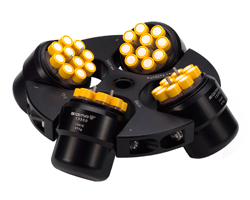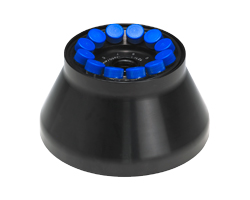
Swing-bucket rotors
Swing-bucket rotors for sedimantation with smaller centrifugal forces of up to approximately 6000 x g, for use in medical and research laboratories.
Advantages:
A higher yield may be obtained as it is possible to fill the centrifuge test tube completely, sedimentation takes place in the middle of the bottom of the test tube enabling easy separation of the phases.

Fixed-angle rotors
Fixed-angle rotors are used for sedimentation with high centrifugal forces of up to and more than 60 000 x g typically needed in research laboratories.
Advantages:
Fixed-bucket rotors allow shorter sedimentation times in comparison to swing-bucket rotors as higher rotational speeds and higher centrifugal forces can be achieved. The sedimentation distance is also generally shorter than with swing-bucket rotors which also has a positive influence on the sedimentation time. The capacity of the rotor chamber can be better utilized than with swing-bucket rotors.

Drum rotors
Drum rotors are specialized rotors for higher rotational speeds or - to be precise - for higher centrifugal forces, the vessels (usually reaction vials) are held in cassettes and placed vertically into the rotor. The sedimentation method is similiar to swing-bucket rotors.
Advantages:
In comparison to swing-bucket rotors the drum rotors feature higher rotational speeds and thereby higher centrifugal forces.
The available rotors for a specific SIGMA centrifuge can be found on the pages describing the centrifuge.

